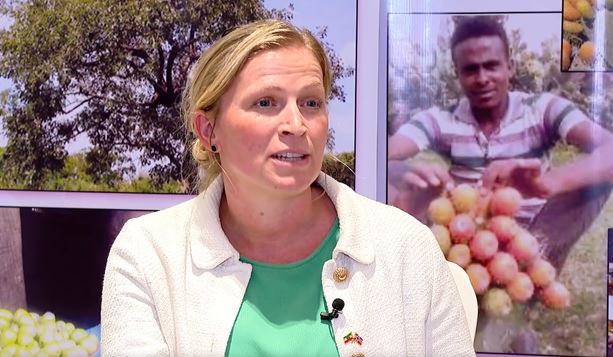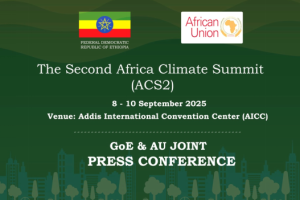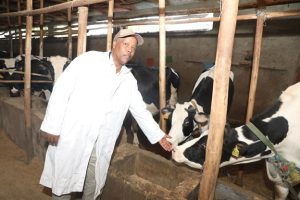
Global collaboration on climate change mitigation is critical for successfully implementing diverse projects, as the effects of climate change transcend national borders and necessitate collective action. It also establishes shared responsibility among responsible bodies. Climate change is a worldwide issue that impacts all countries, regardless of the degree of development. Collaborative approaches recognize that all nations bear responsibility for reducing greenhouse gas emissions and working toward a sustainable future.
Collaboration across countries also gives long-term sustainable solutions to the detrimental effects of climate change. Effective climate change mitigation necessitates a long-term approach that incorporates future generations. Global collaboration develops a common vision of sustainable development that balances economic growth and environmental stewardship.
Ethiopia is a member of a global community that is extremely sensitive to climate change due to a combination of geographic, economic, and social reasons. Its geographic diversity and varied terrain, which include mountains, plateaus, and lowland sections, render it vulnerable to many climate effects. For example, the highlands are prone to soil erosion and landslides, but lowland areas are vulnerable to drought and desertification.
Additionally, Ethiopia has experienced significant deforestation over the years, resulting in biodiversity loss, ecosystem degradation and increased vulnerability to natural disasters droughts, and flooding.
Ethiopia, unlike the summer wheat program, relies on rain-fed agriculture. Agriculture provides a living for a large section of Ethiopia’s people, with the majority of farming activities being dependent on rainfall. Changes in precipitation patterns, longer droughts, and the increased frequency of extreme weather events have a significant impact on agricultural output and food security.
Climate change also has an impact on the availability of water in the country. Recurrent droughts present the country with water-related issues. Droughts bring water shortages for drinking and agricultural reasons, which has an influence on agriculture and human health. More importantly, it worsens food insecurity in Ethiopia by reducing crop yields and livestock productivity. This is especially troubling for vulnerable communities that rely on subsistence farming.
Taking these realities into account, Prime Minister Abiy Ahmed (PhD) unveiled the Ethiopian Green Legacy Initiative on May 26, 2019. The Initiative was launched in response to Ethiopia’s substantial environmental challenges, including soil erosion, climate change, and deforestation.
The first phase of the Green Legacy program lasted from 2019 to 2022. The goal of planting 40 billion trees was established to meet the country’s severe reforestation needs and rebuild degraded areas. The initiative aimed not only to mitigate the effects of deforestation and climate change but also to promote sustainable development and improve the livelihoods of those who rely on forest resources.
Following the completion and review of the first phase, Prime Minister Abiy Ahmed (PhD) launched the second phase of the Green Legacy Initiative in the Afar area in June 2023 under the theme “Let’s Plant the Future Today.” According to the Prime Minister, planting trees is in harmony with nature since it offers food and beauty while also helping to minimize the consequences of climate change.
According to him, 25 billion tree seedlings would be planted during the Green Legacy’s second phase. When coupled with the 25 billion seedlings planted in the first phase, Ethiopia becomes the first country to plant 50 billion saplings. He further underlined that the Green Legacy initiative puts quality ahead of quantity. The Prime Minister went on to declare that the Initiative will favor indigenous seedlings that can withstand the effects of climate change and are more suited for food and medicine.
He also indicated that integrated forestry is part of Ethiopia’s efforts to achieve food self-sufficiency and that both indigenous trees and edible fruit trees such as apples would be planted. The second phase of the Green Legacy Program includes 60 percent mixed plantation seedlings, 35 percent forest seedlings, and 5 percent urban beauty seedlings.
Accordingly, the country’s successive efforts to implement GLI have garnered international support and admiration from countries. For example, the Royal Norwegian Embassy in Addis Ababa has praised Ethiopia’s demonstrable achievements through its Green Legacy Initiative (GLI).
It added that the Ethiopian Green Legacy Initiative, launched in 2019, is a large-scale reforestation effort aimed at combating deforestation, restoring degraded landscapes, and enhancing environmental resilience. The target is to plant 50 billion trees by 2026.
Live Jacob Sydness, Counselor, and Special Envoy for Climate at the Royal Norwegian Embassy in Addis Ababa, emphasized the GLI as an effective model for other nations during the 14th International Day of Forests celebration in Addis Ababa.
During the 14th International Forests and Food event in Addis Ababa, Sydness told local media that Ethiopia is successfully restoring degraded lands. She emphasized the environmental protection efforts of the Ethiopian government over the past six years that have resulted in visible and tangible changes.
“The GLI has brought about a major transformation in Ethiopia’s landscapes and the bilateral agreement between Norway and Ethiopia on environmental protection complements this progress,” she added. Sydness also emphasized that the initiative and the collaboration between Norway and Ethiopia on forestry are closely aligned. “I want to congratulate Ethiopia for the impressive efforts and the results achieved,” she remarked.
Highlighting Ethiopia’s decisive political leadership in implementing the Green Legacy Initiative, Sydness suggested that it could serve as a model for other nations facing similar challenges.
She attributed the initiative’s success to broad stakeholder engagement and praised Ethiopia’s dedicated rehabilitation fund for fostering further progress.
Sydness also noted Norway’s long-standing support for Ethiopia’s forest conservation since 2011, emphasizing their collaboration on community afforestation, and forest preservation.
According to Sydness, the active participation of local forest communities in planning and decision-making is crucial. “Involving local communities is the cornerstone of our bilateral relationship,” she stated.
The Special Envoy noted the cooperation of Norway and Ethiopia has also focused on women’s land rights, recognizing their vulnerability to forest degradation, stressing the importance of women’s central role in conservation efforts, and noting the transformative impact on their lives, families, and children.
Indeed, Ethiopia and Norway have entered into a number of bilateral agreements targeted at improving climate resilience and encouraging sustainable practices. These agreements frequently address issues such as renewable energy, forestry, and agriculture.
Furthermore, Norway has been supporting and participating actively in the Ethiopian Green Legacy Initiative. Besides, Ethiopia and Norway’s collaboration on climate change mitigation has been marked by a strong commitment to sustainable development, environmental protection, and mitigating the effects of climate change. As a result, the Ethiopia-Norway cooperation demonstrates a shared commitment to addressing the global climate problem through joint activities that promote sustainability, resilience, and social fairness. Their collaboration should serve as a lesson for other countries.
BY EPHREM ANDARGACHEW
THE ETHIOPIAN HERALD TUESDAY 25 MARCH




